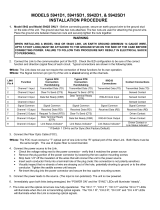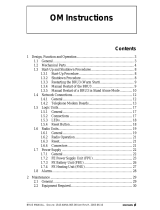
The engineering manual contains instructions on how to engineer the IEDs using the various
tools available within the PCM600 software. The manual provides instructions on how to set
up a PCM600 project and insert IEDs to the project structure. The manual also recommends a
sequence for the engineering of protection and control functions, as well as communication
engineering for IEC 61850.
The installation manual contains instructions on how to install the IED. The manual provides
procedures for mechanical and electrical installation. The chapters are organized in the
chronological order in which the IED should be installed.
The commissioning manual contains instructions on how to commission the IED. The manual
can also be used by system engineers and maintenance personnel for assistance during the
testing phase. The manual provides procedures for the checking of external circuitry and
energizing the IED, parameter setting and configuration as well as verifying settings by
secondary injection. The manual describes the process of testing an IED in a substation which
is not in service. The chapters are organized in the chronological order in which the IED should
be commissioned. The relevant procedures may be followed also during the service and
maintenance activities.
The operation manual contains instructions on how to operate the IED once it has been
commissioned. The manual provides instructions for the monitoring, controlling and setting of
the IED. The manual also describes how to identify disturbances and how to view calculated
and measured power grid data to determine the cause of a fault.
The application manual contains application descriptions and setting guidelines sorted per
function. The manual can be used to find out when and for what purpose a typical protection
function can be used. The manual can also provide assistance for calculating settings.
The technical manual contains operation principle descriptions, and lists function blocks, logic
diagrams, input and output signals, setting parameters and technical data, sorted per
function. The manual can be used as a technical reference during the engineering phase,
installation and commissioning phase, and during normal service.
The communication protocol manual describes the communication protocols supported by
the IED. The manual concentrates on the vendor-specific implementations.
The cyber security deployment guideline describes the process for handling cyber security
when communicating with the IED. Certification, Authorization with role based access control,
and product engineering for cyber security related events are described and sorted by
function. The guideline can be used as a technical reference during the engineering phase,
installation and commissioning phase, and during normal service.
1.3.2
Document revision history
GUID-34B323E4-1319-4D42-80CE-29B0F2D36E2C v2
Document
revision
Date Product revision History
- 2017–05 2.2.0 First release for product version 2.2
A 2017–10 2.2.1 Ethernet ports with RJ45 connector added.
B 2018–03 2.2.1 Document enhancements and corrections
C 2018–06 2.2.2 Technical data updated for PSM. Case dimensions
updated.
D 2018–11 2.2.3 Functions CHMMHAI, VHMMHAI, DELVSPVC,
DELISPVC and DELSPVC added. Updates/
enhancements made to ZMFPDIS, ZMFCPDIS,
CCRBRF, REALCOMP, PTRSTHR and FNKEYMDx.
Ordering section updated.
E
2019-05 2.2.3 PTP enhancements and corrections
Section 1 1MRK 511 395-UEN E
Introduction
4 LON, 670 series
Communication protocol manual
© Copyright 2017 ABB. All rights reserved

























